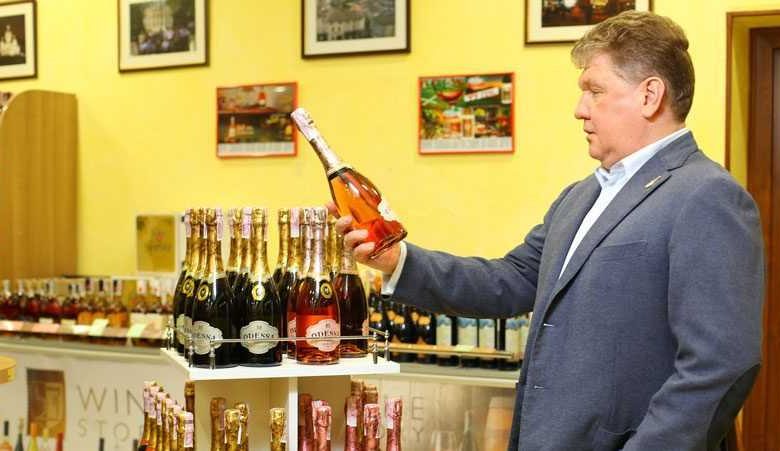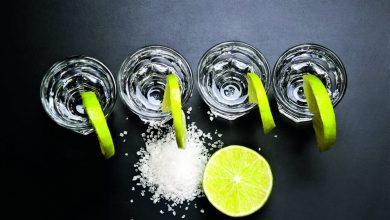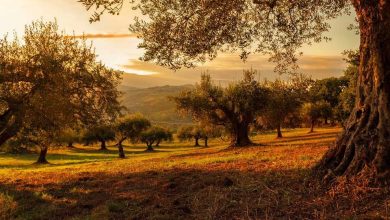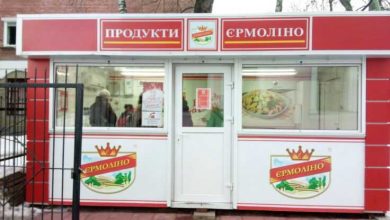
Dmitry Sayfudinov, the co-owner of “Vinfort” company has been well aware of the peculiarities of Odessa Sparkling Wine Company work since 1990s. He could observe the development of the factory. Sayfudinov worked in Kiev district Komsomol committee in Odessa. He and his four Komsomol friends organized a law firm “Meta Inform”. The lawyers consulted businessmen on commercial law and they did not lack clients. “Odessa Sparkling Wine Company” was one of them. “We consulted the factory administration on legal and business issues”, tells Sayfudinov. Soon OSWC and “Meta Inform” created a joint venture “Agromyr” which dealt with the sales of sparkling wine “Odessa”.
Most of the companies sold “Soviet Sparkling Wine” (“Sovetskoye Shampanskoye”) at that time and this name was fully accepted by customers. To sell a new brand product was not an easy task. “It was difficult, but we managed to do it. It was our first experience of distribution”, tells Sergei Chernenko, the co-owner of “Vinfort” company and the Chairman of the OSWC Board. He was the head of “Agromyr” company. For instance, in 1997 OSWC produced 18 million bottles of sparkling wine. The partners sold 14 million of that amount in Ukraine. The rest was exported to Russia. The company also started to import alcoholic drinks. This cooperation had lasted for five years until the management of the plant changed. The new head of the enterprise was appointed at the general employees meeting. “New administration was not market oriented; they did not understand many processes. In addition they did not realize all the benefits from cooperation with “Agromyr” company”, claims Sayfudinov. They stopped collaboration for a couple of years. Soon after that OSWC income started to fall and they faced serious financial difficulties. The company was acquired by “Overline” Concern owned by Boris Kaufman. By 2009 the plant became a leader in the industry. “Odessa” brand had 22% of the Ukrainian sparkling wine market. At that time Sayfudinov with his partners established and successfully developed “Vinfort” company. They specialized on the import of alcoholic drinks.

Italian “Gruppo Campari” company purchased OWSC in 2009. But something went wrong and the business was not successful. In a few years the Italians were looking for a new owner for the plant. “Vinfort” wanted to purchase a facility for a long time. The company was looking through West Ukrainian distilleries. Sayfudinov says it could help to balance the group investment portfolio. However the partners could not find an appropriate manufacture. When “Gruppo Campari” decided to sell the plant in 2014, they immediately seized this opportunity. Moreover they had enough experience working with OSWC products.
The enterprise was built at the end of the XIX century by French wine-maker Henri Roederer. There are still old 9-meter deep wine cellars in the building. There are also some pieces of old furniture. One of the walls in the tasting room is furnished with massive antique oak cupboards. But the production facilities are completely upgraded.


 Why did you purchase OSWC? At the moment of this purchase your company “Vinfort” was developing very successfully and steadily. And OSWC could be worthless in the condition you bought it. Didn’t the financial condition of the enterprise scare you? It could have been a failure.
Why did you purchase OSWC? At the moment of this purchase your company “Vinfort” was developing very successfully and steadily. And OSWC could be worthless in the condition you bought it. Didn’t the financial condition of the enterprise scare you? It could have been a failure.
A well balanced alcohol group has to be based on several components. A domestic producer with an import portfolio is a necessary condition for steady business. We were planning this purchase for a few years. First of all we had to earn enough money to make our dream true. Building a new plant required great investments. After the 2008-2009 crises the import declined significantly. We realized that we definitely needed domestic production basis. Therefore when “Gruppo Campari” announced that they were ready to sell “Odessa Sparkling Wine Company”, we decided to take part in the competition.
The Italians purchased the plant for $18 million in 2009 and sold it to you several times cheaper. What do you think was the reason of “Gruppo Campari” business failure in Ukraine?
In 2008 OSWC produced 16 million bottles and at that moment the Italians paid the market price for it. “Gruppo Campari” wanted to use this production facility of well-promoted domestic sparkling wine in order to combine it with their import portfolio. To my mind things went wrong with the management. The Italians paid too much attention to the manufacturing facility upgrade. But trading is a different kind of art. They were not engaged in marketing and product advertising at all. In addition the changes in label design were not successful. Before we purchased the plant the trade volume had already declined to 3.5 million bottles annually. That was a catastrophic decrease. Nowadays “Gruppo Campari” is focused on the import of its products.

What was your anti-crisis strategy after you purchased the plant?
We invested in new technologies which allow us to save up natural gas and water in the production process. In particular, natural gas consumption has declined five times.
Did you purchase the plant for your own money or on credit?
The main investor was “Vinfort” company. We used our own resources and intended to invest the money earned by “Vinfort”. We ran out of funds due to the devaluation of the national currency. That is why we took hrivna loans. The crisis in 2008 taught us not to have dollar loans. We had lots of foreign currency loans at that time. High interest rate in Ukrainian banks is one of the main factors which keep Ukrainian business from development. Frankly speaking, this year we have invested three times less than it was planned. It is just approximately $1 million.
What do you believe can help you gain better positions on the market and defeat the competitors?
We do not want to defeat anybody; we just want our market share back. Before purchasing OSWC we carried out considerable marketing research. The loyalty to “Odessa” brand was high but it remained archaic, while other products were developing. How do we want to get our market share back? Nowadays “Odessa” brand has a totally fresh image, a new bottle, new wine and a new chief wine-maker. We have changed “Odessa” style, made it lighter and even with the touch of Italian “frisk”. Our advantage is that we are located in the middle of wine-making area so we can purchase the best wine basis. We expect 2016 to be a breakthrough year for us. With the law that bans the usage of communist symbols, “Sovetskoye Shampanskoye” will stop its existence. Both leaders of the mass-market Kharkov and Kiev plants, which produce only semi-sweet version of the product, will have to create their own brands. The competition will become fair.
Are you going to extend OSWC brand portfolio?
Renewed “Odessa” was launched only half a year ago. There are nine sparkling wine varieties in our product line, including two kinds of brut (rose and white). We will produce one more brut “Blanc de Blanc” in 2016. The demand for brut category is growing rapidly. Previously about 1 billion bottles of vodka was produced annually in Ukraine. But today its production fell to 800 million. The production of wine accounts for 300 million bottles. In three years we expect our volumes to be increased by 2.5 times, to 10 million bottles. In 2016 we plan to start producing sparkling wine “Prince Vladimir the Great” and some low-alcohol drinks for youth.
Are you going to export your products?
OSWC has always exported its products. The plant supplied sparkling wine to Russia and countries with Ukrainian diaspora: Canada, Israel and the USA. Even today Odessa Sparkling Wine Company is the third largest sparkling wine exporter in Ukraine. In 2016 we are going to double our export.
How are you going to solve the issue concerning the name of the product? Will you continue using “champagne” or change it for “sparkling wine” on your labels?
We will use “sparkling wine”. Our new rose brut “Odessa” already has “sparkling wine” on its label.
Where did you study management?
During 1990s we were attending different trainings, reading business literature. There were no instructors and the knowledge in the area was just developing. The guru of management Ichak Adizes, his trainings and books had an immense impact on me. I deeply grasped his “Corporate Lifecycle Theory” and “Four Vitamins Theory”. “The Ideal Executive: Why You Cannot Be One And What To Do About It” and “Managing Corporate Lifecycles” are two basic books. They played a significant role in holistic viewpoint developing. We implemented Adizis’ ideas on our own. They became our basis, which prevents us from wasting time for unreasonable arguments. If some disagreements appear we solve them according to Adizes, appealing to our main basis.
I read books in macroeconomics which are usually studied to acquire Master of Business Administration degree, books by Jack Trout and my favorite Adizes. I offer employees to read Adizes’ books too. I do not insist on that, but strongly recommend. Our employees attend trainings and after that they write reports about the conclusions they made.
You have been working with your business partners for more than 20 years already? How do you manage to get on well and not to have any corporate conflicts?
It is very important to trust your partners and not to interfere with their responsibility sphere. We succeeded in one very important aspect; we did not let money overcome human values in our partnership. There are not two of us in the business and even not three. We are five partners. We have never faced the problem like “who works longer, has more rights”. Everybody has their own equal shares in business. We had heated arguments concerning business development and strategy choice. We argued before and do it now as well. But money is not the reason of our disagreements. We did not share responsibility spheres at once. Everything was achieved gradually.
Do you willingly delegate authority? How do you hire the top-managers?
All authorities are delegated. From the very beginning we were choosing candidates according to decency principle. Our main top-managers have been working with us for 18 years already. It means that we have created a favorable atmosphere on the enterprise. Today the HR manager is responsible for recruiting.
How often do the owners control the team work? Who makes key decisions in the company?
We hold brief meetings with top managers on Mondays, share the information. All business activities are processed by “Intalev” system, which was developed specially for us. Besides, we have quarterly and annual reports. All top-managers report on how we have worked during a certain period. All partners may look through our financial documents at any time. The main decisions including the ones about investments are made by all the shareholders at the general meetings.







